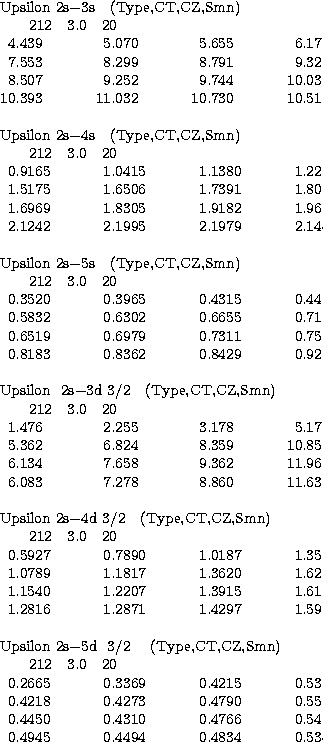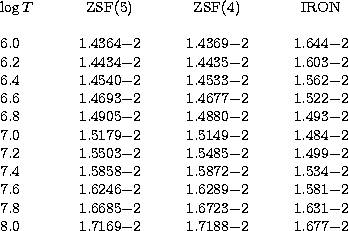 |
As well as the standard 5-point cubic spline fit, the new program OmeUpZ allows the options of varying the number of nodal points, and of using quadratic splines (in which case the knots are at mid-nodal points) or Tchebyshev polynomials.
In general, global fits with Tchebyshev polynomials are not suitable for
this type of data, especially if resonance contributions are appreciable.
For such data, piecewise fits with low-degree splines are more appropriate,
and in extreme cases it may be best to resort to linear splines (see B&T
Sect. 6.2).
However, Tchebyshev fits are very useful for other types of data which
might be expected to have a convergent power series expansion over the whole
range. The ZSF data is very smooth so, as an example of using the program
in this mode, we also give results obtained from 4-point Tchebyshev fits to
![]() . For these, the interpolation function
. For these, the interpolation function
![]() is used in place of
is used in place of
![]() , both these functions being defined in
terms of FORTRAN listings in the Appendix. This gives an even more compact
representation of the data, and still to about 1% accuracy provided the
range of nuclear charge is limited to
, both these functions being defined in
terms of FORTRAN listings in the Appendix. This gives an even more compact
representation of the data, and still to about 1% accuracy provided the
range of nuclear charge is limited to ![]() , which covers
most cases of astrophysical interest. The results are given in Table 5.
, which covers
most cases of astrophysical interest. The results are given in Table 5.
 |
As an example to compare with we have run the interactive program described
in the Appendix for the case of the ![]() transition in
transition in
![]() . In Table 6 we give the corresponding
. In Table 6 we give the corresponding ![]() as a
function of logT. The column headed ZSF(5) has results obtained by using
as input to the interactive program the spline data in Table 4. The numbers
in Col. ZSF(4) are obtained in a similar way but using the Tchebyshev data
given in Table 5. In the final column of Table 6 we give results from the
IRON Project (see Berrington & Tully 1997). There is good agreement for most
of the temperatures in the table although at the lowest ones the IRON results
clearly exceed those of ZSF(5) and ZSF(4). This is explained by the effect of
resonances which Berrington & Tully take account of whereas ZSF do not. Most
of the collision strengths considered by Berrington & Tully are greatly
modified by resonances at relatively low energies. As a result of this
the resonances only have a strong effect on the thermally averaged collision
strengths at temperatures which are well below those of astrophysical
importance, i.e. where
as a
function of logT. The column headed ZSF(5) has results obtained by using
as input to the interactive program the spline data in Table 4. The numbers
in Col. ZSF(4) are obtained in a similar way but using the Tchebyshev data
given in Table 5. In the final column of Table 6 we give results from the
IRON Project (see Berrington & Tully 1997). There is good agreement for most
of the temperatures in the table although at the lowest ones the IRON results
clearly exceed those of ZSF(5) and ZSF(4). This is explained by the effect of
resonances which Berrington & Tully take account of whereas ZSF do not. Most
of the collision strengths considered by Berrington & Tully are greatly
modified by resonances at relatively low energies. As a result of this
the resonances only have a strong effect on the thermally averaged collision
strengths at temperatures which are well below those of astrophysical
importance, i.e. where ![]() is expected to be abundant under
conditions of coronal ionization equilibrium. Another small difference can
be seen to occur at the highest temperature where the ZSF results exceed
those of the IRON Project by a few percent. This is explained by the fact that
ZSF's calculation is fully relativistic and therefore takes account of both
the magnetic effects and the Lorentz transformation of electron velocities
mentioned in Sect. 1.1 of B&T. On the other hand the IRON Project
calculation allows only for the magnetic effects but treats the kinematics
of the collision classically. A proper relativistic treatment of the
colliding electron's velocity can profoundly modify the collision strength at
high energies and hence affect
is expected to be abundant under
conditions of coronal ionization equilibrium. Another small difference can
be seen to occur at the highest temperature where the ZSF results exceed
those of the IRON Project by a few percent. This is explained by the fact that
ZSF's calculation is fully relativistic and therefore takes account of both
the magnetic effects and the Lorentz transformation of electron velocities
mentioned in Sect. 1.1 of B&T. On the other hand the IRON Project
calculation allows only for the magnetic effects but treats the kinematics
of the collision classically. A proper relativistic treatment of the
colliding electron's velocity can profoundly modify the collision strength at
high energies and hence affect ![]() at high temperatures.
at high temperatures.
Copyright The European Southern Observatory (ESO)